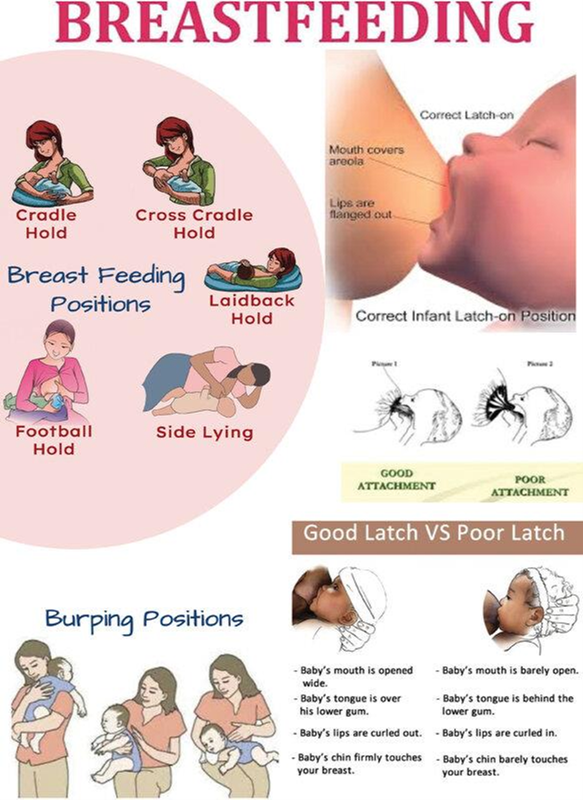A nurse is reinforcing teaching about breastfeeding with the mother of a full-term newbornwho is 5 days old.
Which of the following statements by the mother indicates an understandingof the teaching?
My baby should breastfeed 5 to 10 minutes on each breast.
I should not wake my baby during the night to breastfeed.
I should keep my baby on a strict feeding schedule.
I should have my baby latch on to my nipple and areola during feeding.
The Correct Answer is D
Having the baby latch on to both the nipple and areola during breastfeeding is essential for effective milk transfer and optimal breastfeeding. The baby should take in a good portion of the areola along with the nipple to ensure a proper latch and a comfortable feeding experience for both the mother and the baby. This allows the baby to obtain enough milk and stimulates milk production in the mother.
Let's briefly discuss the other statements:
A- "My baby should breastfeed 5 to 10 minutes on each breast": The duration of breastfeeding can vary from baby to baby, but it is generally recommended to allow the baby to breastfeed until they are satisfied and have emptied one breast before switching to the other breast. This ensures that the baby receives both the foremilk and the hindmilk, which are important for adequate nutrition.
B- "I should not wake my baby during the night to breastfeed": In the early days after birth, it is important to establish frequent and regular breastfeeding to support milk production and ensure the baby receives enough nourishment. Newborns typically need to breastfeed at least 8 to 12 times in 24 hours, including during the night. If the baby is sleeping for a long period, it may be necessary to wake them for feeding to ensure proper nutrition and hydration.
C- "I should keep my baby on a strict feeding schedule": Breastfeeding should be based on the baby's cues and demand rather than a strict schedule. Newborns should be breastfed whenever they show hunger signs, such as rooting, sucking motions, or increased alertness. This helps establish a good milk supply and allows the baby to feed according to their individual needs.

Nursing Test Bank
Naxlex Comprehensive Predictor Exams
Related Questions
Correct Answer is A
Explanation
Monitoring the infant's lymphocyte count is important in evaluating the immune function of the infant. HIV primarily affects the immune system, including lymphocytes. Monitoring the lymphocyte count helps assess the progression of the disease and the effectiveness of treatment.
Exchange transfusions are not typically used in the management of HIV. They are primarily performed in conditions like severe neonatal jaundice or blood disorders, but not for the treatment of HIV.
Granulocyte colony-stimulating factor (G-CSF) is a medication used to stimulate the production of white blood cells called granulocytes. While G-CSF can be used in certain situations, such as to counteract the side effects of certain chemotherapy drugs, it is not a standard treatment for HIV in infants.
Droplet precautions are typically implemented for infectious diseases that spread through respiratory droplets, such as influenza or respiratory syncytial virus (RSV). HIV does not spread through respiratory droplets, so initiating droplet precautions would not be necessary in the care of an infant with HIV.
Correct Answer is A
Explanation
Insulin lispro is a rapid-acting insulin, while insulin glargine is a long-acting insulin. It is important to keep them separate to maintain their individual properties and avoid any potential interactions or changes in their effectiveness.
Insulin glargine is a clear solution and should not appear cloudy. Cloudiness in insulin can indicate contamination or improper storage.
The instruction to "take an extra dose of insulin lispro prior to aerobic exercise" is not recommended. The client should consult with their healthcare provider to determine if any adjustments to their insulin regimen are necessary for exercise. Typically, adjustments are made based on the individual's blood glucose levels and anticipated intensity and duration of exercise. Insulin glargine is a long-acting insulin that provides a steady release of insulin over a prolonged period, without distinct peaks or valleys in its action. Its onset of action is gradual and its effect lasts for approximately 24 hours.
It is important for the client to receive accurate and appropriate instructions regarding their insulin regimen. The nurse should clarify any misunderstandings and provide accurate information to promote safe and effective diabetes management.
Whether you are a student looking to ace your exams or a practicing nurse seeking to enhance your expertise , our nursing education contents will empower you with the confidence and competence to make a difference in the lives of patients and become a respected leader in the healthcare field.
Visit Naxlex, invest in your future and unlock endless possibilities with our unparalleled nursing education contents today
Report Wrong Answer on the Current Question
Do you disagree with the answer? If yes, what is your expected answer? Explain.
Kindly be descriptive with the issue you are facing.
